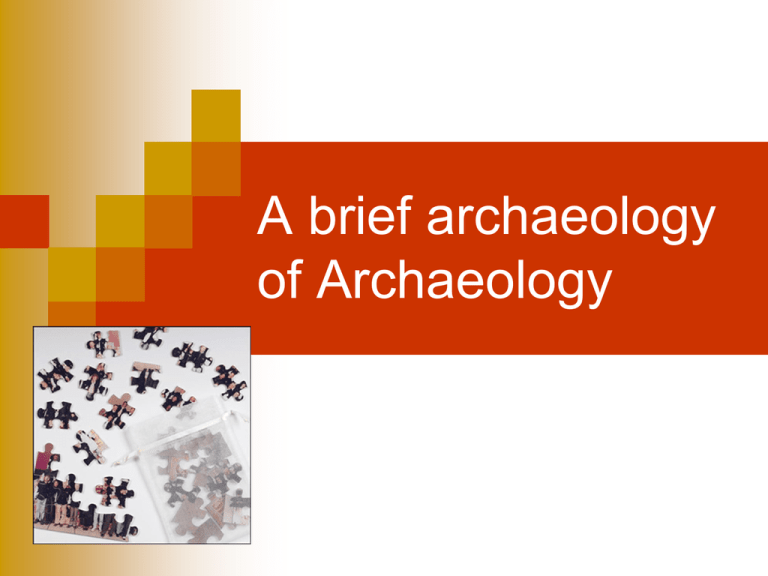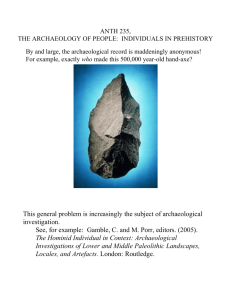Lecture 2 History of Archaeology
advertisement

A brief archaeology of Archaeology “Moments in the prehistory of archaeology” Thutmose IV, Pharaoh of Egypt,15th century BC, excavates the Sphinx. Nabonidus (last King of Babylon) excavates at Babylon in 6th century BC [declares there were earlier civilizations “before us”] 1492, “New World” discovery demands new explanations in biblical interpretation in Europe Ruins of Pompeii discovered 1594 Antiquarianism develops with basic attempts at classification of relics by collectors Interest in antiquities expands following invasion of Egypt by Napoleon Rosetta stone uncovered, 1799. (British possession in 1801). Hieroglyphics deciphered by linguist/mathematician Jen Jacques Champollion 1860s Schliemann excavates at Troy and Mycenae 1880s: Discoveries of early hominid skeletons spurs the science of paleo-anthropology 1900-1920 Arthur Evans excavates at Knossos on Crete, reveals the Minoans. 1920s Leonard Woolly excavates at Ur (spurs Sumerimania) Howard Carter unearths the tomb of Tutankhamen (spurs Egyptomania) 2a Terms and jargon Archaeological culture Phase Period Tradition Culture area Horizon Artifacts, ecofacts, features Sites Regional sampling Area sampling Chronologies: relative and absolute Stratigraphy Experimental archaeology Olmec jaguar-human infant hybrid of carved jadite. Artifacts Any object made or modified by humans Includes, but is not limited to, pottery; tools of stone, metal, wood; glass; jewelry, ritual objects; weapons of any type, textiles and clothing; storage containers, cooking implements; writing; In essence, all forms of portable material culture. May also include debitage: refuse from tool manufacturing and many forms of garbage. Features Any non-portable element of material culture on a site. Includes any and all architecture, roads, footpaths, wells, hearths (fire pits) post holes, trash dumps, modified natural landscape, mines, canals, and earthworks. May also include fixed art (cave paintings and petroglyphs. Also includes foundations and platforms. Cognitive-landscape attributes are considered features by many archaeologists, such as sacred landscapes or places “of power” and lines of sight. Ecofacts Any natural aspect of site remains that indicates human activities. Examples include charcoal, seeds, gourds, pollen, food remains, antler, animal skins, bones with evidence of butchering, ore, slag, cultivated plants, and much more, including coprolites. These are clues to foodways, agricultural and food procurement practices (subsistence patterns) and social interaction. Coprolite (fossil feces) “little gifts from the past” Material culture Tangible products of human behavior and interaction. A chair or a knife is material culture; a belief, a ceremony, a preferred food is not. Ceremonies, and other abstract expressions of behavior and cognition (culture) may have tangible material accoutrement, which offer archaeologists with clues to cultural practices. We may not observe a social process or cultural practice, but we can interpret or infer it from material culture evidence. Next: Origins of Humanity The Neanderthal question. Culture systems and processes Invention Diffusion Migration Bands Tribes and clans Chiefdoms Proto-states States Exchange systems Unilinear cultural evolution Multilinear cultural evolution A sampling of theoretical approaches to archaeological study Optimal foraging theory Cultural ecology Diffusionism Evolutionary ecology Culture history “new archaeology” Environmental archaeology Cultural processualism Post-processualism






